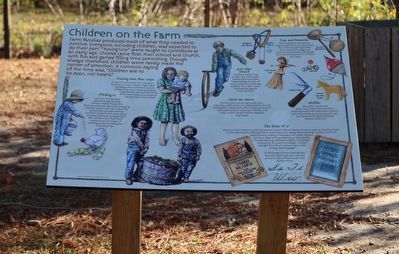Conway in Horry County, South Carolina — The American South (South Atlantic)
Children on the Farm
— L. W. Paul Living History Farm —
Raising more than crops
It was not uncommon for couples to have ten or more children. High infant mortality rates could leave parents childless, with one sweeping epidemic. Large families allowed farmers to tend more corps and acreage by having built-in work hands.
Pitching in
Common chores were gathering eggs, feeding animals, tending the garden, fetching water and wood, and emptying chamber pots. As girls got older, they looked after younger siblings and had a larger role in sewing and cooking. Boys took on bigger jobs like cutting wood, fieldwork, construction, and repair of buildings, as well as taking part in hunting trips.
Just rollin' around
Keeping a metal hoop upright and rolling with a guide stick was called hoop rolling. The size of the hoop varied with what was available from farm parts. Experienced players could do tricks.
Hand-me-downs
Getting new clothes was a rare treat. A Sunday outfit, shoes, or a coat would be the big holiday gift. Clothes were often made by hand and were passed down to younger siblings until they couldn't be patched and repaired any longer.
The three "R's"
Education was limited to what the nearest school offered. Students had to walk or travel by horse, to the regional schoolhouse. Often more than a mile away. Teachers taught grades 1-10 in the same building, making it necessary for older children to help in class with younger ones. Basic studies including reading, writing, and arithmetic. Breaks were given for lunch and recess. Children brought food from home in lunch pails or bags called "pokes."
During heavier work periods like harvest, older boys were needed at home. School had to wait until slower times.
Toys and treasures
Rich imagination and games played a big role in young people's fun. Store-bought toys were rare treats for holidays and very special occasions. Handmade items were treasures for children of all ages.
Whittlin'
Boys often borrowed Dad's very sharp knife. Accidents while learning knife skills were a painful part of growing up. Carrying your own was handy and a right of passage toward manhood.
Erected by L. W. Paul Living History Farm.
Topics. This historical marker is listed in these topic lists: Education • Parks & Recreational Areas.
Location. 33° 54.338′ N, 79° 2.858′ W. Marker is in Conway, South Carolina, in Horry County. Marker can be reached from Harris Short Cut Road west of U.S. 701, on the right when traveling west. This marker is next to the fence facing the farmhouse. Touch for map. Marker is at or near this postal address: 2279 Harris Short Cut Rd, Conway SC 29526, United States of America. Touch for directions.
Other nearby markers. At least 8 other markers are within walking distance of this marker. Farm House (a few steps from this marker); The Legacy of Farm to Table (a few steps from this marker); Ole' Time Religion (within shouting distance of this marker); L.W. Paul Living History Farm (within shouting distance of this marker); Taking Stock of Animals on the Farm (within shouting distance of this marker); Raising Cane (about 300 feet away, measured in a direct line); Gristmill (about 300 feet away); Wood to Wagon (about 300 feet away). Touch for a list and map of all markers in Conway.
Also see . . . The L.W. Paul Living History Farm. Horry County Museum (Submitted on December 6, 2023.)
Credits. This page was last revised on December 7, 2023. It was originally submitted on December 6, 2023, by Sandra Hughes Tidwell of Killen, Alabama, USA. This page has been viewed 42 times since then and 10 times this year. Photo 1. submitted on December 6, 2023, by Sandra Hughes Tidwell of Killen, Alabama, USA. • Bernard Fisher was the editor who published this page.
